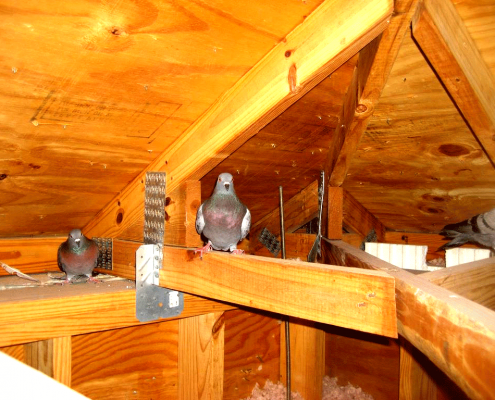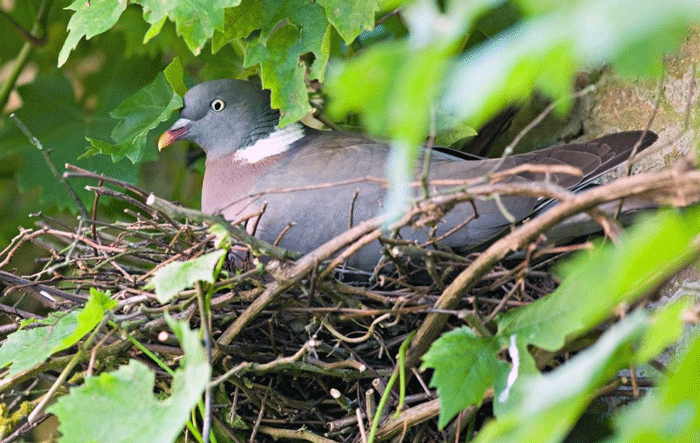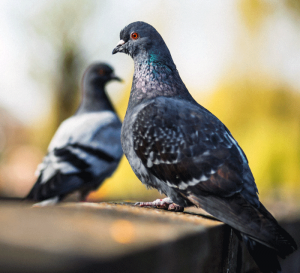
In most places, pigeons are a common sight. While they appear similar to other birds, if you look closely enough, you will be able to identify how they differ from other bird families.
Pigeons are rather much more distinct than expected. From the colors and patterns of their feathers, to the shape and size of their bodies, to the sounds they make, or the food they intake.
If they are compared to different birds, they are most similar to doves. These two often only differ in their size and sometimes in their colors. However, other qualities are either identical or similar.
Despite this, pigeons remain their own kind of bird with specific qualities that are only shared by birds of their family.
Pigeon Solutions
Pigeon Description
Pigeons are a common sight in a lot of places, whether it’s an urban or rural neighborhood.
One way to quickly identify a pigeon by their appearance is by looking at the proportions of their heads and legs. Usually, they have small heads in comparison to their bodies and easily identifiable short legs.
They come in different colors, but the most common is a gray-blue color along with rainbow-like feathers that go around their necks and their chests. Most pigeon wings have two dark-colored bands while some have crosses located on their tail feathers.
Some pigeons that come from different places or are a different specie come in different colors. For example, fruit pigeons are typically soft-billed and their plumage is often greenish with yellow, red, and other brightly colored markings. Blue pigeons, on the other hand, are dark blue with red wattles, while crowned pigeons have a blue-gray color with fanlike head crests.
Pigeons usually appear gentle and plump-looking. They have small bills with a skin saddle between their bill and forehead, which is called a cere.
A distinct characteristic that pigeons have is the way they strut while bobbing their heads.
When it comes to identifying their tracks, it’s comparable to that of a mourning dove. However, pigeons are much more common which makes them easier to locate.
Their tracks often have one long central toe with two slightly shorter toes on either of the sides, along with a shorter toe at the back that appears connected directly to their middle toe.
In terms of size, their tracks are normally more than 2 inches long from the tip of the center toe on the front to the end of their back toe.
Pigeons generally have short legs, which is why their tracks aren’t far apart from each other. There is a rather small distance between each step, therefore, making it easier to identify.
Bird droppings are often similar to one another, but this can depend on what type. For pigeons, they are more of the solid kind.
They appear around the size of a small marble, are firm, and typically a white-brown color. If the bird is healthy, there would be a few tiny feathers along with it. If not, their droppings may be liquid or wet.
Pigeon droppings usually have little to no odor at all. However, if it does produce a pungent stench, then it may be a bad sign. This happens when the bird is infected with an illness or disease.
One thing about pigeon droppings is that they can be dangerous to hold, or even come in contact with. This is because their droppings often contain pathogens that carry or can cause different diseases.
Pigeon droppings that get dried out can turn into dust or powder which can spread through the air, making it far more dangerous than if it were in a solid-state.
In some cases, pigeon droppings will have feathers in them. These are possibly the droppings that come from their nest. Take note that pigeons don’t clean up the droppings of their young, therefore increasing the possibility of said droppings falling to the ground or spreading.
If you have pigeons close to your home, be wary of the droppings and clean them with precaution as soon as you can to keep them from drying out.
The sounds they make are quite distinct compared to other birds, although they produce a lot of different sounds.
What most people hear from them every day is their call when attracting mates or defending their territories. This is close to the sound most birds make, something like a rolling “R” sound.
This is called cooing. The coo is a call that pigeons use with lengthened sound. While it’s generally used to call a mate, it is also used for communication between the birds. They also make grunting noises when they are distressed or to indicate that there is something alarming to others.
Pigeons also tend to have different movements when they are cooing. Before pigeons take flight, they tend to create different noises by stamping their feet or slapping their wings together. Along with their cooing, they also make sounds by fanning their tails, inflating their throats, bowing, or
strutting.
Seeds are common food to pigeons. This is the major component of their diets. They often eat this along with corn, wheat, and cereals. Every now and then they have some fruits or greens.
However, this can vary by species. There are ground-feeding pigeons that focus on feeds like fruit, insects, or worms.
Some of them exclusively eat nothing but seeds or human food scraps which mostly consists of fast food wastes. Another species eats vegetables and berries as well.
When pigeons are in cities, they tend to consume anything edible available to them or within their vicinity. It could be human garbage, grains and seeds, vegetables, fruits, insects, snails, worms and much more.
Although it may seem odd to find a pigeon rummaging through leftover wastes, this is a common act for pigeons that live in bigger cities with less natural food.
Pigeons typically set their nests on edges of high places such as the ledges of tall buildings, caves, crevices on rocky cliffs, and the like. Sometimes you can find them under bridges or overpasses as well.
Location
One unique trait pigeons have when finding a spot for their nest is that they rarely set it on trees like most birds. A pigeon’s nest can be found in surprising parts of the city, commonly on different buildings and high sites.
This is because they focus on setting their nest in a location that is in a dry and protected area with a flat surface where they can nest and perch.
The male pigeon is usually the one to initiate the nesting process by locating a potential nest site and sitting there as they call for a mate. When this is successful, he starts his search for materials and brings a single twig at a time which the female tucks around herself.
They take turns in watching over the nest. The male keeps watch of it during the day, while the female handles the duties during the night time.
Appearance
One word to describe a pigeon’s nest is messy. When people think of nests, they usually picture a well-made round shaped bed made from sticks almost in the shape of a bowl. However, this isn’t the case for pigeons.
Their nests are simply different materials merged together with a hole in the center. It typically consists of sticks, small twigs, grass stems, pine needles, debris, and other similar materials that are piled together keeping space in the center.
When their nests are used repeatedly over time, they are full of feathers and dropping. The reason it ends up this way is because, unlike other birds, they don’t dispose of their young’s droppings from the nest.
As a result, the accumulated droppings tend to serve as a sort of cement material to keep the nest together and stay-put in a single place and shape.
When a pair of pigeons reuse their nest site, they tend to add new materials to the already made nest which are placed just on top of the finished product regardless of whether there are droppings or not.
One thing to note is that a reused pigeon nest can contain a lot of odd remains because they build a new one atop of it instead of changing it or cleaning it out.
These would include their young’s droppings, unhatched eggs, or even the corpses of their pigeon babies that have passed.
A nest can also reach up to 8 inches in height, 20 inches in width, and weigh 4 pounds or more if it were to be reused for about 3 to 4 years.

The stereotype set for pigeons is that they are simple winged animals providing you entertainment every once in a while, as you sit on a park bench and offer them some bread crusts.
This is the way they are usually depicted in TV shows and cartoons. What some people aren’t aware of is that behind this reputation, pigeons are actually less safe than you would expect them to be.
Surprisingly, pigeons carry a number of pathogens that can spread diseases. Fortunately, these diseases are rarely fatal to humans. These include salmonella and different flu-like illnesses.
Some of the diseases you can get from pigeon droppings are:
- Histoplasmosis – an infection that comes from inhaling fungal spores present in soil containing pigeon droppings. This can be dangerous particularly for people with weaker immune systems despite only seeming like the common flu.
- Candidiasis – commonly appears in the mouth and throat areas. They may also affect the skin, respiratory system, intestines, and urogenital tract.
- Cryptococcosis – a fungal infection that doesn’t get contracted as easily as the first two diseases. However, it can cause damage to your lungs and nervous system.
- Psittacosis – also known as “Parrot Fever”. This usually comes from dried bird droppings or discharge coming from a bird’s beak and eyes. In rare cases, it can cause serious lung infections.
- Salmonellosis – one of the most common and most dangerous diseases that you can get from pigeon droppings. This is often spread through droppings but can also be spread in different ways.
The main way pigeons can transmit these diseases is through their droppings.
It’s common knowledge not to touch or pick up pigeon droppings with bare hands. However, this isn’t always enough to prevent the catching of said illnesses.
Pigeon droppings, which are infected with bacteria and viruses, are often left out, which causes them to dry out. When this happens, they tend to powderize and eventually get blown into the air.
This increases the chances that you may inhale the droppings and therefore also take in the bacteria or viruses that come with it. Through this, the disease is spread even when you don’t come in direct contact with their droppings.
It’s important to note that when you find pigeon droppings nearby or on your property, you should dispose of them quickly. Make sure you are taking precautions by protecting your exposed skin and covering your nose and mouth to avoid accidentally inhaling dried droppings.
Pigeon droppings can also be dangerous other than by spreading disease.
When they are scattered on the floor, they can create slippery conditions which makes it hazardous and harder to clean up.
